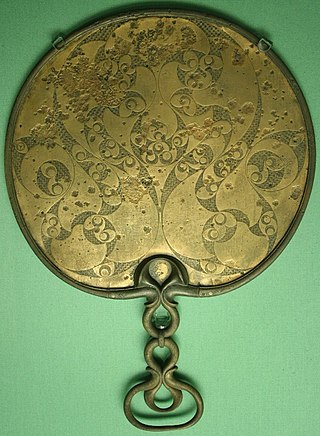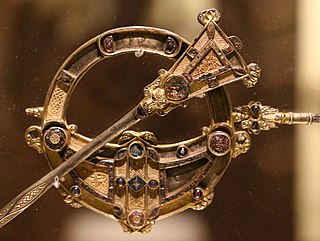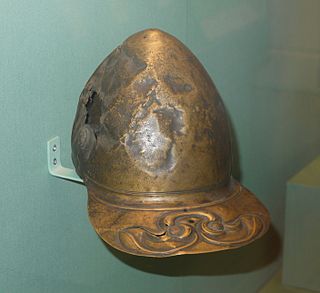
The La Tène culture was a European Iron Age culture. It developed and flourished during the late Iron Age, succeeding the early Iron Age Hallstatt culture without any definite cultural break, under considerable Mediterranean influence from the Greeks in pre-Roman Gaul, the Etruscans, and the Golasecca culture, but whose artistic style nevertheless did not depend on those Mediterranean influences.

A torc, also spelled torq or torque, is a large rigid or stiff neck ring in metal, made either as a single piece or from strands twisted together. The great majority are open at the front, although some have hook and ring closures and a few have mortice and tenon locking catches to close them. Many seem designed for near-permanent wear and would have been difficult to remove.

The Gundestrup cauldron is a richly decorated silver vessel, thought to date from between 200 BC and 300 AD, or more narrowly between 150 BC and 1 BC. This places it within the late La Tène period or early Roman Iron Age. The cauldron is the largest known example of European Iron Age silver work. It was found dismantled, with the other pieces stacked inside the base, in 1891, in a peat bog near the hamlet of Gundestrup in the Aars parish of Himmerland, Denmark. It is now usually on display in the National Museum of Denmark in Copenhagen, with replicas at other museums; during 2015–16, it was in the UK on a travelling exhibition called The Celts.

Horned helmets were worn by many people around the world. Headpieces mounted with animal horns or replicas were also worn since ancient history, as in the Mesolithic Star Carr. These were probably used for religious ceremonial or ritual purposes, as horns tend to be impractical on a combat helmet. Much of the evidence for these helmets and headpieces comes from depictions rather than the items themselves.

Celtic art is associated with the peoples known as Celts; those who spoke the Celtic languages in Europe from pre-history through to the modern period, as well as the art of ancient peoples whose language is uncertain, but have cultural and stylistic similarities with speakers of Celtic languages.

The ancient carnyx was a wind instrument of the Iron Age Celts, used between c. 200 BCE and c. CE 200. It was a type of bronze trumpet with an elongated S shape, held so that the long straight central portion was vertical and the short mouthpiece end section and the much wider bell were horizontal in opposed directions. The bell was styled in the shape of the head of an open-mouthed boar or other animal.

Situla, from the Latin word for bucket or pail, is the term in archaeology and art history for a variety of elaborate bucket-shaped vessels from the Bronze Age to the Middle Ages, usually with a handle at the top. All types may be highly decorated, most characteristically with reliefs in bands or friezes running round the vessel.
The Witham Shield is an Iron Age decorative bronze shield facing of La Tène style, dating from about the 4th century BC. The shield was discovered in the River Witham in the vicinity of Washingborough and Fiskerton in Lincolnshire, England in 1826. Further excavations at a nearby site have revealed posts interpreted as the foundation for a causeway, as well as artefacts including a sword, spears and part of a human skull with a sword fragment lodged within. The shield is now in the British Museum.

The prehistory of Ireland has been pieced together from archaeological evidence, which has grown at an increasing rate over the last decades. It begins with the first evidence of permanent human residence in Ireland around 10,500 BC and finishes with the start of the historical record around 400 AD. Both the beginning and end dates of the period are later than for much of Europe and all of the Near East. The prehistoric period covers the Palaeolithic, Mesolithic, Neolithic, Bronze Age and Iron Age societies of Ireland. For much of Europe, the historical record begins when the Romans invaded; as Ireland was not invaded by the Romans its historical record starts later, with the coming of Christianity.

The Bullion Stone is a late carved Pictish stone, which is unusual in containing a figure; it dates to c. 900–950. It was discovered in 1933 at Bullion field, Invergowrie, during the construction of a road and is now located in the Museum of Scotland in Edinburgh. The image on the stone is unique amongst Pictish stones discovered thus far. It depicts a bald, bearded man on a weary horse, carrying a shield and drinking from a very large drinking horn with a bird's head terminal, a parallel that has been noted to the Torrs Horns, also in the museum, of nearly 1,000 years earlier.

The Celtic brooch, more properly called the penannular brooch, and its closely related type, the pseudo-penannular brooch, are types of brooch clothes fasteners, often rather large; penannular means formed as an incomplete ring. They are especially associated with the beginning of the Early Medieval period in Ireland and Britain, although they are found in other times and places—for example, forming part of traditional female dress in areas in modern North Africa.

The Waterloo Helmet is a pre-Roman Celtic bronze ceremonial horned helmet with repoussé decoration in the La Tène style, dating to circa 150–50 BC, that was found in 1868 in the River Thames by Waterloo Bridge in London, England. It is now on display at the British Museum in London.

The Meyrick Helmet is an Iron Age bronze peaked helmet, with La Tène style decoration, that is held at the British Museum in London. It is one of only four Iron Age helmets to have been discovered in Britain, the other three being the more famous Waterloo Helmet, the Canterbury Helmet and the North Bersted Warrior helmet. Unlike the Waterloo Helmet, which bears two cone-shaped horns, the Meyrick Helmet is hornless and appears to be based on a Roman model. Vincent Megaw, emeritus professor of archaeology at the University of Leicester, has conjectured that the helmet may have belonged to a British auxiliary fighting in the Roman army during the campaigns against the Brigantes in AD 71–74.

The Wandsworth Shield is a circular bronze Iron Age shield boss or mount decorated in La Tène style which was found in the River Thames at Wandsworth in London sometime before 1849. Another incomplete bronze shield mount, sometimes called the Wandsworth Mask Shield was found at the same time. Both shield mounts are now held at the British Museum. The bold repoussé decoration on the Wandsworth Shield, comprising two birds with outstretched wings and long trailing tail feathers, has led Barry Cunliffe, Emeritus Professor of European Archaeology at the University of Oxford, to consider the shield to be "among the masterpieces of British Celtic art".

The Hunterston Brooch is a highly important Celtic brooch of "pseudo-penannular" type found near Hunterston, North Ayrshire, Scotland, in either, according to one account, 1826 by two men from West Kilbride, who were digging drains at the foot of Goldenberry Hill, or in 1830. It is now in the National Museum of Scotland, Edinburgh. Made within a few decades of 700 AD, the Hunterston Brooch is cast in silver, gilt, and set with pieces of amber, and decorated with interlaced animal bodies in gold filigree. The diameter of the ring is 12.2 cm, and in its centre there is a cross and a golden glory representing the risen Christ, surrounded by tiny bird heads. The pin, which is broken, can travel freely around the ring as far as the terminals, which was necessary for fastening; it is now 13.1 cm long, but was probably originally 15 cm or more.

The National Museum of Ireland – Archaeology is a branch of the National Museum of Ireland located on Kildare Street in Dublin, Ireland, that specialises in Irish and other antiquities dating from the Stone Age to the Late Middle Ages.

Prehistoric art in Scotland is visual art created or found within the modern borders of Scotland, before the departure of the Romans from southern and central Britain in the early fifth century CE, which is usually seen as the beginning of the early historic or Medieval era. There is no clear definition of prehistoric art among scholars and objects that may involve creativity often lack a context that would allow them to be understood.

Nancy Katharine Sandars was a British archaeologist and prehistorian. As an independent scholar, she wrote a number of books and a popular version of the Epic of Gilgamesh.

The Keshcarrigan Bowl is an Iron Age bronze bowl discovered to the north of Keshcarrigan, County Leitrim, Ireland, in the 19th century. The bowl was found in the waterway between Lough Scur and Lough Marrave. It was perhaps a ceremonial drinking cup. The bowl would have been a prestigious item in 1st century Ireland, the bird-shaped handle outstandingly designed and skillfully executed. The Keshcarrigan Bowl is in the archaeology branch of the National Museum of Ireland.

Llyn Cerrig Bach Plaque is a bronze plaque that dates from 200BC to AD100 in the Iron Age, found at Llyn Cerrig Bach.






















